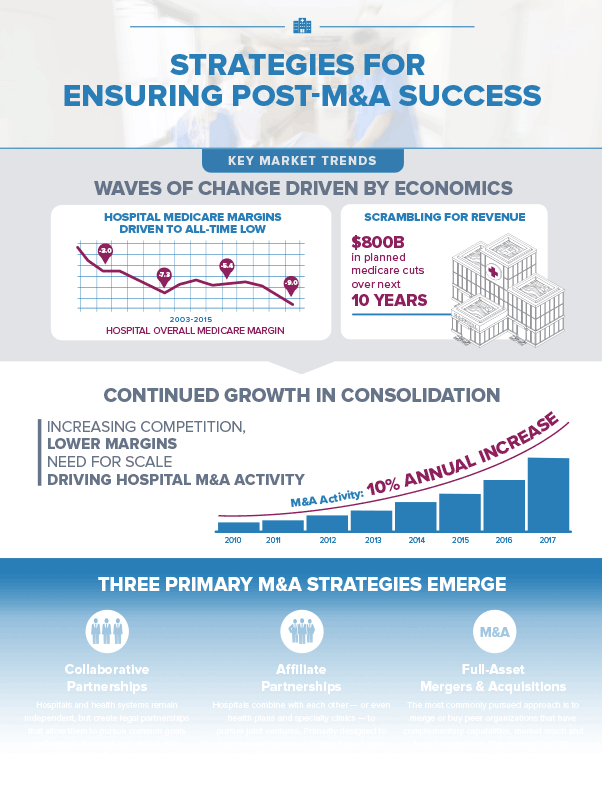Hospitals are merging at an accelerated rate. But M&A alone won’t guarantee success. Hospitals need a plan to smooth the integration process and show quick results.
The Rationale for Hospital Mergers & Acquisitions
In today’s US health care market, consolidation is a continuous and anticipated reality as hospitals and clinics seek to increase competition and lower margins. Since 2010, merger and acquisition (M&A) activity involving hospitals and clinics has increased at a rate of 14%. And that number is only expected to climb. In fact, the Modern Healthcare article, “Record Numbers, Better Credit in 2017 M&A Dealmaking,” reported that each of the past four years have seen over 100 deals made, with 2017 being the biggest on record at 115 mergers and acquisitions.
The strategies behind M&A are well-intentioned. They seek to provide mutually beneficial outcomes focused on attracting more patients, building loyalty and expanding offerings. As the most commonly pursued approach, full-asset M&A is an excellent fit for organizations that have complementary capabilities, market reach, and brand reputations. Not surprisingly, the quickest path to financial gains is through M&A. That is, as long as the integration goes smoothly. On the other hand, collaborative partnerships allow hospitals and clinics to remain independent, but also pursue common goals and mitigate risks. At the same time, affiliate partnerships enable hospitals to combine with each other to explore joint ventures. Though all good options, each M&A strategy comes with post-M&A challenges.
Challenges Related to M&A Activity
The not-so-pretty truth about M&A in all industries, not just health care, is that only a small percentage of deals deliver the intended financial results in the first few years of joint operation. Blending cultures, connecting workflows and integrating brands is never as easy as it seems in the planning stages. In fact, years of siloed decision-making within each hospital has often resulted in fragmented departments. Broken processes and workplace or environmental challenges create a landslide of negative consequences. Including the potential loss of valuable clinical staff. Integration within one hospital is often tricky, much less two or more.
Many consultancies offer change management services to organizations going through mergers, acquisitions and various forms of affiliation and partnership. But these same firms require a sizable investment and take a considerable amount of time to implement fully. As a result, hospitals are seeking alternate solutions for building a culture and achieving their financial goals today.
Nationwide, hospitals are identifying and implementing proven solutions for accelerating the integration process. These solutions focus on helping integrate departments, workflows, and processes that otherwise would remain siloed or fragmented. Making these connections is leading to the quick realization of both savings and efficiency gains. More importantly, however, they are further empowering clinicians to focus on what matters most – patient care – by retaining top talent and therefore, ensuring patient satisfaction.
To learn more about these integration solutions, download our infographic entitled, Strategies for Ensuring Post-M&A Success. This infographic covers:
- Waves of change driven by economics
- Continued growth in consolidation
- Emergence of three primary M&A strategies, and
- Three ways hospitals can improve post-M&A integrations and outcomes
Discover more insights at our Resource Center.













